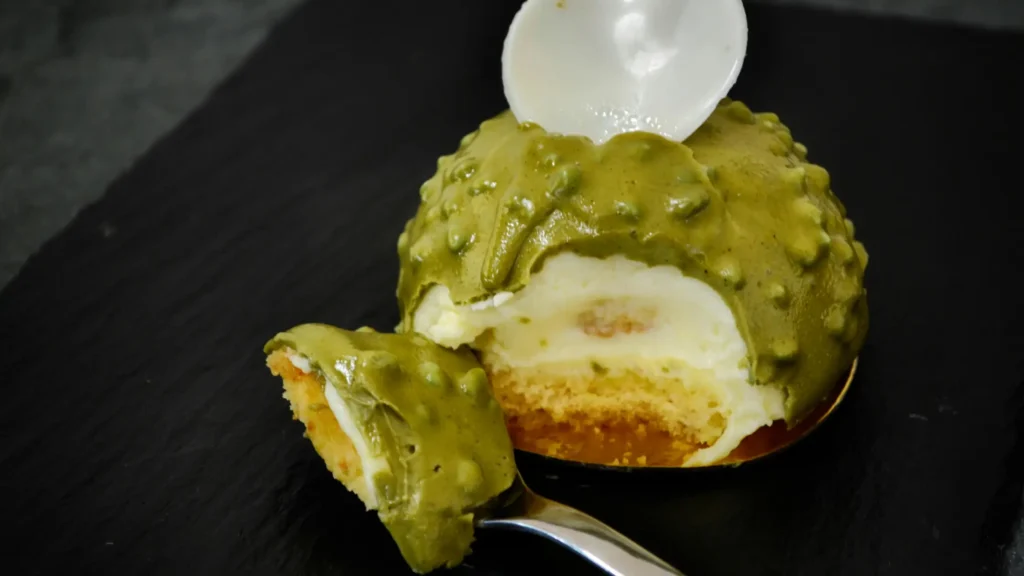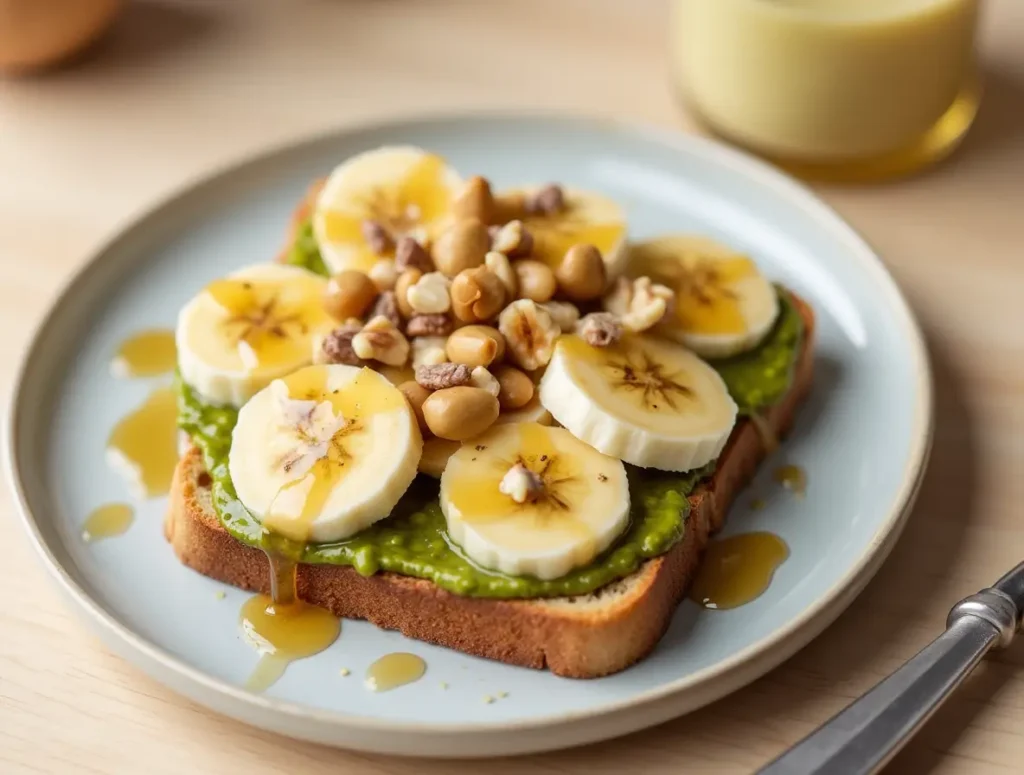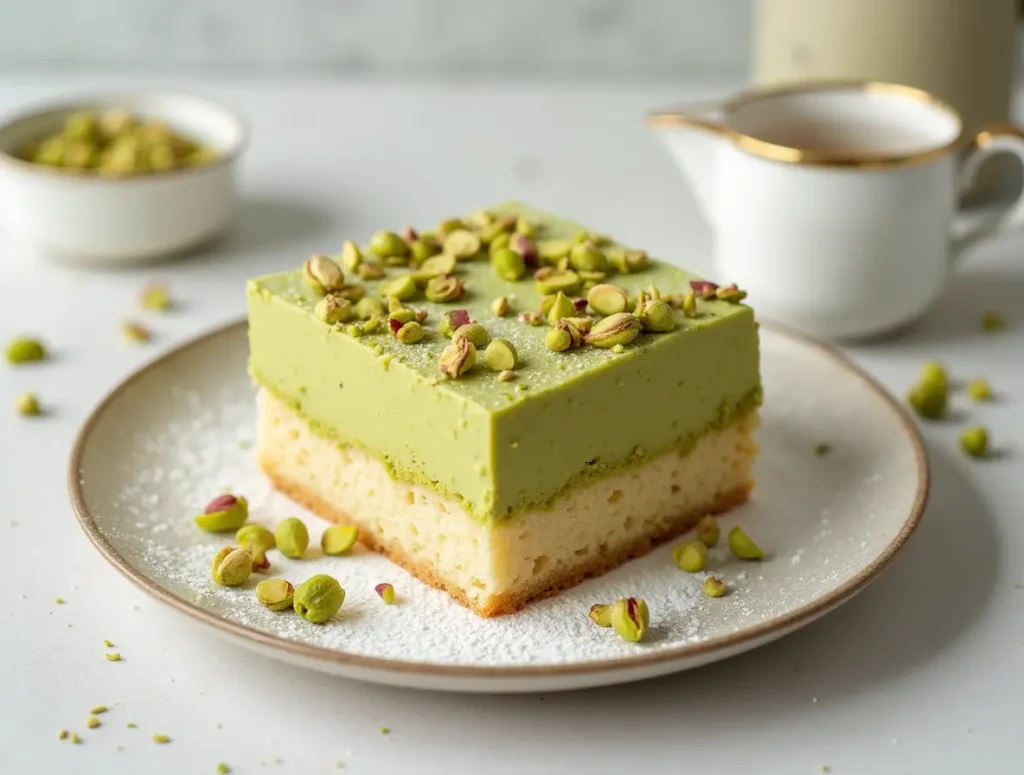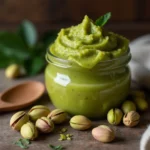Table of Contents
Pistachio paste is one of those ingredients that can completely elevate your cooking and baking game. Known for its rich, nutty flavor and creamy texture, this versatile paste is becoming a go-to addition in kitchens worldwide. Whether you’re creating decadent desserts like pistachio ice cream or adding a unique twist to savory dishes, pistachio paste can be the secret ingredient to take your recipes to the next level.
Making pistachio paste at home is easier than you might think—and it’s a great way to enjoy a fresher, more flavorful version than store-bought options. Plus, you can customize it to your liking, adjusting the texture and sweetness to suit your taste. In this step-by-step guide, we’ll show you exactly how to make pistachio paste from scratch, along with some delicious ways to incorporate it into your favorite recipes. Ready to discover the magic of pistachio paste? Let’s dive in!
What is Pistachio Paste and How is It Different from Pistachio Butter?
Pistachio paste is a creamy, smooth blend made from roasted or raw pistachios. It’s used in both savory and sweet dishes, providing a nutty flavor and a rich texture. While it’s similar to other nut-based pastes, like almond butter or peanut butter, pistachio paste offers a unique flavor profile that can add a special touch to your recipes. But how exactly does it differ from pistachio butter, and why should you choose pistachio paste over other nut pastes? Let’s dive into the details.

If you’re a fan of unique, delicious flavor combinations, you can take your Choc Chip Ice Cream Sandwiches to the next level by adding a layer of homemade pistachio paste. This simple and healthy spread not only enhances the flavor profile but also pairs beautifully with the creamy texture of the ice cream. Whether you’re creating a gourmet dessert or just looking to try something new, pistachio paste adds a rich, nutty twist to your choc chip ice cream sandwich recipe, making it an irresistible treat in just 10 minutes!
Pistachio Paste vs. Pistachio Butter: Differences in Texture, Consistency, and Use
While pistachio paste and pistachio butter are both made from pistachios, their textures and uses can vary significantly.
- Texture and Consistency: Pistachio butter is typically smoother and can be spread easily due to the higher oil content. Pistachio paste, on the other hand, is often slightly thicker and has a denser texture, making it ideal for blending into recipes or using as a filling in pastries. The texture of pistachio paste can be adjusted based on how much oil or other ingredients are added, but it is generally less runny than butter.
- Uses: Pistachio butter is great for spreading on toast or mixing into smoothies, while pistachio paste is often used in more complex dishes, especially in baking and cooking. It’s perfect for making creamy sauces, flavored frostings, or even pistachio-flavored ice cream. It can also be incorporated into savory recipes like pasta dishes or meat marinades.
What Makes Pistachio Paste Special?
Pistachio paste stands out due to the unique, rich flavor of pistachios themselves. Unlike peanut or almond butter, pistachio paste carries a delicate balance of sweetness and nuttiness, making it versatile in both savory and sweet dishes. Here’s what makes it special:
- Nutty Sweetness: Pistachios offer a subtle, naturally sweet flavor that’s more refined than some other nuts. This gives pistachio paste a unique, luxurious taste that can enhance everything from cakes to salad dressings.
- Smooth and Creamy Texture: The paste’s consistency allows it to blend seamlessly into dishes, providing smoothness without overpowering the other ingredients. When you use it in desserts, it helps create a rich, velvety texture that’s hard to beat.
- Vibrant Green Color: The bright green hue of pistachio paste not only makes your dishes look beautiful but also gives them an appealingly fresh appearance, especially in recipes like ice creams or frostings.
Why Choose Pistachio Paste Over Other Nut Pastes?
Pistachio paste is not just delicious—it also comes with a range of health benefits that make it a great alternative to other nut-based pastes. Here are a few reasons to consider making pistachio paste part of your kitchen staples:
- Higher in Nutrients: Pistachio paste is rich in essential vitamins and minerals, including vitamin B6, which supports metabolism and brain health, as well as magnesium, which helps regulate blood sugar and muscle function. Compared to other nut pastes like peanut butter, pistachio paste often has a higher content of antioxidants and healthy fats, providing a nutritious boost to your meals.
- Good for Heart Health: Pistachios are packed with heart-healthy fats, including monounsaturated and polyunsaturated fats, which can help reduce cholesterol levels and improve cardiovascular health. Using pistachio paste in your recipes is a delicious way to support your heart health without sacrificing flavor.
- Rich in Protein and Fiber: Pistachios are a great source of plant-based protein and fiber, which can help keep you fuller for longer and support digestive health. By incorporating pistachio paste into your diet, you’re adding a nutrient-dense option to your meals that also satisfies hunger.
- Suitable for Special Diets: Pistachio paste is naturally gluten-free and vegan, making it an ideal choice for people following specific dietary needs. Unlike some nut butters that contain added sugars, preservatives, or unhealthy fats, homemade pistachio paste allows you to control the ingredients and create a pure, wholesome product.
Ingredients and Tools You’ll Need to Make Pistachio Paste
Making pistachio paste at home requires just a few simple ingredients and tools. With these, you can create a delicious, versatile paste that’s perfect for baking, spreading, or adding flavor to various dishes. Here’s what you’ll need:
Main Ingredients
To create the perfect pistachio paste, these are the essential ingredients:
- Fresh Pistachios: The star of the show! Choose high-quality, raw pistachios for the best flavor. While you can use roasted pistachios, using raw pistachios gives you more control over the flavor and texture. If you prefer a smoother paste, you may want to blanch the pistachios first to remove the skins.
- Optional Sweeteners (Honey, Sugar, or Maple Syrup): Depending on your intended use for the pistachio paste, you might want to add a touch of sweetness. Honey is a popular choice for a natural, floral sweetness, while granulated sugar or maple syrup can offer a different flavor profile. You can modify the amount to suit your personal taste.
- Salt: A pinch of salt can enhance the flavor of the pistachios, balancing out the natural nuttiness and sweetness. Use fine salt to ensure it dissolves well into the paste. You can also experiment with flavored salts (like smoked salt) for a unique twist.
- Oil (for Texture): To achieve a creamy consistency, you’ll need a little oil. Neutral oils like sunflower or grapeseed oil work well, as they don’t overpower the pistachio flavor. For a richer paste, you can also use pistachio oil, which will give the paste a more intense nutty taste. The amount of oil depends on how smooth or thick you want your paste.
Tools to Use
These tools are key to making the pistachio paste both quickly and efficiently:
- Food Processor: A high-powered food processor is essential for blending the pistachios into a smooth, creamy paste. It helps break down the nuts evenly, and you can adjust the blending time to achieve your desired texture. Some food processors may require scraping the sides occasionally, so keep a spatula handy.
- Spatula: A spatula is a handy tool for scraping the pistachio paste from the sides of the food processor and ensuring even mixing. It also helps in transferring the paste into your storage container without wasting any delicious paste.
- Storage Containers: Once your pistachio paste is ready, it’s important to store it properly. Glass jars or airtight containers are perfect for keeping the paste fresh and preventing it from drying out. Be sure to use containers that can be sealed tightly to maintain freshness for longer periods.
Customization Options
One of the best things about making pistachio paste at home is how easy it is to customize the flavor and texture to your liking. Here’s how you can make it your own:
- Texture (Smooth vs. Chunky): If you prefer a smoother paste, blend the pistachios for a longer time. For a chunkier texture, stop blending once the pistachios start to break down but still have some texture left. You can also pulse the food processor intermittently to control the consistency.
- Flavor Add-ins: Get creative with the flavor of your pistachio paste! Here are a few options:
- Vanilla: Adding a teaspoon of vanilla extract will provide a warm, aromatic note that complements the pistachio flavor perfectly.
- Cinnamon: A pinch of ground cinnamon adds a cozy, spicy warmth that pairs wonderfully with the nuttiness of pistachios.
- Cardamom: For a more exotic flavor, try adding a small amount of cardamom. It’s particularly great in Middle Eastern or Mediterranean-inspired dishes.
- Chocolate: Blend in some cocoa powder for a chocolatey pistachio paste that can be used in desserts like cookies or cakes.

Step-by-Step Guide to Making Pistachio Paste at Home
Making pistachio paste at home is a straightforward process, and with just a few simple steps, you can have a smooth, rich paste that’s perfect for a variety of uses. Follow this guide to ensure the best results.
Step 1: Preparing the Pistachios: Roasting or Blanching Pistachios for the Best Flavor
To create the most flavorful pistachio paste, start with high-quality pistachios. You can use either raw or roasted pistachios, depending on your preference, but roasting the nuts enhances their natural flavor. Roasting will bring out a deeper, nuttier taste that will really shine in the paste.
Roasting:
Preheat your oven to 350°F (175°C). Spread your pistachios in a single layer on a baking sheet and roast them for about 8-10 minutes, stirring halfway through to ensure they’re evenly toasted. Watch them carefully, as nuts can burn easily. Once roasted, let them cool slightly.
Blanching (Optional for smoother paste):
If you prefer a smoother paste, blanching the pistachios is an excellent option. Simply drop the pistachios into boiling water for 1-2 minutes, then drain and immediately rinse with cold water. The skins should slip off easily, leaving behind the tender nut. This step is especially useful if you’re looking for a lighter-colored paste without the darker tones from the skin.
Step 2: Blending the Pistachios: How to Use a Food Processor to Achieve the Right Consistency
Now that your pistachios are prepped, it’s time to transform them into paste! The key to a great pistachio paste is using a food processor to blend the nuts into a creamy texture.
Using a Food Processor:
Place your pistachios into the bowl of a food processor. Start by pulsing the nuts in short bursts to break them down into smaller pieces. As the nuts begin to grind, you’ll notice they start to release their natural oils, and the mixture will begin to clump together. Be patient—it can take a few minutes for the paste to come together. Stop occasionally to scrape down the sides of the bowl for even blending.
Achieving the Right Consistency:
If the pistachio paste still feels too thick or chunky, don’t worry. You can add small amounts of oil (such as neutral oil or pistachio oil) to help smooth it out. Blend until the paste reaches your desired consistency, whether you want it smooth and creamy or slightly textured.
Step 3: Adjusting Texture and Flavor: Adding Oil or Sweeteners for Desired Consistency and Taste
Once your pistachios have turned into a paste, you can customize it further to suit your recipes.
Adjusting Consistency:
If your paste feels too thick or you want a more spreadable texture, you can add a few teaspoons of oil. Use a neutral oil like sunflower or vegetable oil for a mild flavor, or if you want to enhance the nutty taste, try pistachio oil or even olive oil. Add the oil slowly, blending as you go, until the paste reaches your preferred smoothness.
Flavor Adjustments:
Pistachio paste is naturally a bit savory, but you can add a touch of sweetness if you plan to use it in desserts. Consider adding a teaspoon of honey, maple syrup, or agave nectar. For savory applications, a pinch of salt can also enhance the flavor, giving your paste a balanced taste. Taste test as you go and adjust based on your preferences.
Step 4: Storing Pistachio Paste: Tips on Storing Your Paste in Jars for Freshness
Pistachio paste is best stored in an airtight container to maintain its freshness and flavor. Here are some tips on how to properly store it:
Choosing the Right Container:
Glass jars or airtight plastic containers work best for storing pistachio paste. Opt for a container that will hold the paste tightly without much airspace, as exposure to air can cause the paste to lose its flavor more quickly.
Storage Duration:
If you plan to use your pistachio paste within a week, you can store it at room temperature in a cool, dark place. For longer shelf life, refrigerate the paste. It should keep in the fridge for about 2-3 weeks. You can also freeze the paste for up to 3 months—just make sure to store it in a freezer-safe container.
Shelf-Life Tips:
To keep your pistachio paste as fresh as possible, always use a clean spoon when scooping it out of the jar to avoid introducing moisture or contaminants. If you notice any separation (oil rising to the top), simply stir it back in before use.

Delicious Recipes Using Pistachio Paste
Pistachio paste isn’t just a delicious spread or addition to your pantry—it can also be the key ingredient in a wide range of recipes that will impress your family and guests. Whether you’re craving a sweet treat or looking to elevate a savory dish, pistachio paste can be used in various creative ways. Here are some of our favorite recipes to help you make the most of this versatile ingredient:
Pistachio Ice Cream – How to Incorporate Pistachio Paste into Creamy Desserts
Pistachio paste is the perfect base for making rich and creamy pistachio ice cream. The concentrated nutty flavor adds a luxurious touch to the dessert, ensuring each bite is bursting with pistachio goodness. Here’s how you can use pistachio paste for ice cream:
- Base Ingredients: Start by combining pistachio paste with heavy cream, whole milk, sugar, and a pinch of salt.
- Blending: Blend the ingredients together, ensuring the pistachio paste is evenly mixed for smooth texture.
- Churn the mixture in an ice cream maker, following the manufacturer’s instructions.
- Freezing: Once the mixture has reached the consistency of soft serve, transfer it to a container and freeze for a few hours until fully set.
- Serve and Enjoy: Scoop your homemade pistachio ice cream into bowls or cones, and garnish with chopped pistachios or chocolate shavings for added crunch.
The result is a deliciously creamy, homemade ice cream that brings out the full flavor of pistachios.
Pistachio Spread on Toast – A Quick and Easy Savory Breakfast Option
If you’re looking for a quick and easy breakfast, pistachio paste makes for an amazing spread on toast. Its creamy texture and nutty flavor pair perfectly with the crispness of freshly toasted bread, and it can be customized with your favorite toppings for added flair.
- Prepare the Toast: Toast your favorite type of bread (sourdough, whole grain, or even a bagel) until golden brown.
- Spread Pistachio Paste: Generously spread pistachio paste on the warm toast. The heat from the toast will help soften the paste, making it easier to spread.
- Add Toppings: For extra flavor, top your pistachio toast with honey, a drizzle of olive oil, or even some fresh fruit, such as sliced bananas or berries.
- Seasoning Options: Sprinkle a pinch of sea salt or ground cinnamon to enhance the flavor profile, balancing the nutty sweetness of the paste.
This simple yet satisfying breakfast is perfect for those who want a quick, nutrient-packed meal to start their day.
Pistachio Paste in Baking – Adding it to Cakes, Cookies, and Pastries for a Nutty Twist
Pistachio paste isn’t just for savory dishes—it’s a fantastic addition to baked goods too. Adding pistachio paste to cakes, cookies, or pastries gives your treats a rich, nutty flavor that pairs beautifully with both chocolate and fruit.
- Pistachio Cake: Incorporate pistachio paste into your cake batter for a nutty twist. Use it in place of some of the fat or add it to your frosting for a creamy, flavorful finish.
- Pistachio Cookies: Mix pistachio paste into cookie dough to create chewy, nutty cookies. Add a handful of chopped pistachios for extra crunch, or pair with white chocolate chips for an indulgent treat.
- Pistachio Pastries: Use pistachio paste as a filling for croissants, puff pastry, or Danish pastries. Combine it with a bit of sugar and spread it inside the dough before baking for a sweet, aromatic treat.
- Pistachio Muffins: Add pistachio paste to muffin batter to create tender, flavorful muffins. You can combine it with other ingredients like lemon zest or berries for a fruity kick.
The versatility of pistachio paste in baked goods makes it a must-have for anyone looking to add a deliciously nutty flavor to their treats.
Pistachio Sauce for Pasta – How to Use it in Mediterranean Dishes for Rich Flavor
Pistachio paste can even be used in savory pasta dishes, particularly in Mediterranean-inspired recipes. It adds a creamy texture and earthy flavor that perfectly complements fresh herbs, olive oil, and cheese. Here’s how to make a delicious pistachio sauce for pasta:
- Prepare the Pistachio Sauce: Combine pistachio paste with olive oil, garlic, lemon juice, and a splash of vegetable broth or cream. Blend until smooth, creating a velvety sauce.
- Cook the Pasta: Boil your favorite type of pasta (spaghetti, fettuccine, or penne) until al dente, then drain, saving a bit of the pasta water.
- Combine Pasta and Sauce: Toss the pasta in the pistachio sauce, adding a bit of the reserved pasta water if needed to thin out the sauce.
- Garnish: Top with grated Parmesan cheese, fresh basil, or crushed red pepper for a bit of heat.
- Serve: This dish pairs wonderfully with grilled chicken, roasted vegetables, or seafood.
Pistachio sauce is a unique twist on traditional pasta sauces, giving your dish a gourmet touch that’s perfect for dinner parties or weeknight meals.

The Health Benefits of Pistachio Paste
Pistachio paste isn’t just a delicious treat—it also offers a wide range of health benefits, making it a smart choice for anyone looking to enhance their diet with nutritious and flavorful ingredients. Let’s dive into some of the key health benefits of pistachio paste and why it’s a great addition to any kitchen.
For precise nutritional information, you can explore the USDA Nutritional Data on Pistachios, which highlights the vitamins, minerals, and antioxidants packed in this tasty nut.
Packed with Nutrients
Pistachios are a nutritional powerhouse, and when turned into paste, they retain most of these valuable nutrients. One of the standout vitamins found in pistachio paste is Vitamin B6, which plays a key role in promoting brain health, improving mood, and supporting the immune system. Additionally, pistachios are rich in antioxidants, which help to protect your cells from oxidative damage caused by free radicals. These antioxidants, including vitamin E, carotenoids, and polyphenols, are great for maintaining skin health and reducing inflammation.
Another important nutrient in pistachio paste is fiber. Fiber aids in digestion, helps regulate blood sugar levels, and promotes a healthy gut microbiome. With just a small serving of pistachio paste, you’re getting a good amount of fiber, making it a great option for digestive health.
A Healthy Alternative
When compared to many other spreads or nut butters, pistachio paste stands out as a healthier alternative. It’s naturally low in sugar, making it an excellent option for anyone looking to reduce their sugar intake or follow a low-sugar diet. Additionally, pistachio paste is rich in healthy fats, particularly monounsaturated and polyunsaturated fats, which are known to support overall well-being. These healthy fats can help lower bad cholesterol levels (LDL) and increase good cholesterol (HDL), contributing to better heart health.
Pistachio paste is also a great source of plant-based protein, making it a satisfying addition to meals for those seeking a protein boost without relying on animal products.
How Pistachio Paste Can Support Heart Health
The heart-healthy benefits of pistachio paste come from the combination of healthy fats, fiber, and antioxidants. Monounsaturated fats (such as those found in pistachios) are particularly beneficial for reducing the risk of heart disease. These fats help lower levels of LDL cholesterol, the “bad” cholesterol that can clog arteries, while promoting the production of HDL cholesterol, the “good” cholesterol that helps remove fat deposits from the bloodstream.
In addition, pistachio paste contains a compound called l-arginine, an amino acid that can help improve blood flow by relaxing blood vessels and improving circulation. Regular consumption of pistachios or pistachio paste may help reduce blood pressure and support overall cardiovascular health, making it a great addition to a heart-healthy diet.
Perfect for Vegan and Gluten-Free Diets
Pistachio paste is a fantastic option for those following vegan or gluten-free diets. Since it’s made solely from pistachios (and potentially a bit of oil or sweetener), it’s completely plant-based, offering a great source of protein and essential fats for vegans. Plus, pistachio paste is naturally gluten-free, making it a safe and healthy choice for individuals with gluten sensitivities or celiac disease.
Whether you’re using it as a spread, in desserts, or as a savory ingredient, pistachio paste fits seamlessly into both vegan and gluten-free lifestyles. It’s versatile, nutritious, and a delicious way to add variety to your plant-based meals without compromising on flavor or health benefits.
Chef’s Note:
Pistachio paste is more than just a versatile ingredient—it’s a hidden gem in the kitchen that brings both flavor and health benefits to your meals. Whether you’re using it in sweet desserts, savory dishes, or simply spreading it on toast, pistachio paste is a nutrient-packed option that can elevate any recipe.
As a chef, I always recommend making it at home to enjoy its freshest taste and customize the texture and flavor to your preference. Plus, with its heart-healthy fats, antioxidants, and plant-based protein, it’s a choice you can feel good about adding to your diet.
So, why not try making your own pistachio paste today? It’s easier than you think, and I promise you’ll love the difference it makes in your cooking. Happy cooking, and enjoy the rich, nutty goodness of pistachio paste!
Print
Homemade Pistachio Paste Recipe
- Total Time: 15 minutes
- Yield: 1 tablespoon
Description
Pistachio paste is a smooth, rich, and naturally sweet nut butter made from pure pistachios. This versatile paste can be used in desserts, baked goods, ice creams, and even savory dishes. With just a few ingredients and simple steps, you can make a fresh, preservative-free pistachio paste at home in under 15 minutes!
Notes
- Calories: 90
- Fat: 8g
- Carbohydrates: 3g
- Protein: 3g
- Fiber: 1g
- Sugar: 1g
- Prep Time: 10 minutes
- Cook Time: 5 minutes
- Category: Condiments, Dessert Ingredient, Spread
- Cuisine: French, Mediterranean, Middle Eastern
Nutrition
- Calories: 90
Keywords: pistachio paste, homemade pistachio spread, nut butter, pistachio dessert, healthy pistachio recipe



3 thoughts on “How To Make Pistachio Paste At Home: A Step-by-Step Guide”